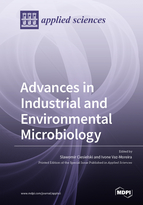Advances in Industrial and Environmental Microbiology
A special issue of Applied Sciences (ISSN 2076-3417). This special issue belongs to the section "Applied Biosciences and Bioengineering".
Deadline for manuscript submissions: closed (30 June 2021) | Viewed by 18045
Special Issue Editors
Interests: biotechnology; microbial biopolymers; metagenomics and metatranscriptomics; diversity of microbial communities; prokaryotic gene regulation
Special Issues, Collections and Topics in MDPI journals
Interests: drinking water; antimicrobial resistance; bacterial diversity; metagenomics; wastewater; taxonomy
Special Issues, Collections and Topics in MDPI journals
Special Issue Information
Dear Colleagues,
The development of civilization entails the need to find new technological solutions leading to products with new properties. Allies in these efforts are microorganisms that have developed skills to synthesize products with properties of interest to the industry. Recently, in the omics era, information about the genetic machinery of microorganisms can be applied in synthetic biology towards new products and services development.
Naturally occurring microorganisms are a potential source of promising bioproducts. Therefore we should take a closer look at the microorganisms inhabiting different environments. However, we know that most microorganisms occupying natural and semi-natural environments are uncultured, and new methodologies leading to new knowledge about these microbes should be promoted. The study of microbial communities and their interactions with an environment is extremely exciting, as is the application of new approaches to try to cultivate new microorganisms.
This Special Issue covers all aspects of the industrial applications of microorganisms including fermentation, biodegradation, biodeterioration, and treatment of waste streams. Articles focused on novel techniques in the bioprocess engineering of peptides, enzymes, and biopolymers as well as their production and purification will be published. In this Special Issue, research papers as well as review articles addressing recent advances on environmental microbiology will be welcomed. Potential topics include microbial diversity, culturomics, microbiomics, microbial community genetics, evolutionary processes, and antibiotic resistance. We also look forward to receiving your manuscripts in which metagenomics, metatranscriptomics, and metaproteomics are used as the main methodology.
Dr. Slawomir CiesielskiDr. Ivone Vaz-Moreira
Guest Editors
Manuscript Submission Information
Manuscripts should be submitted online at www.mdpi.com by registering and logging in to this website. Once you are registered, click here to go to the submission form. Manuscripts can be submitted until the deadline. All submissions that pass pre-check are peer-reviewed. Accepted papers will be published continuously in the journal (as soon as accepted) and will be listed together on the special issue website. Research articles, review articles as well as short communications are invited. For planned papers, a title and short abstract (about 100 words) can be sent to the Editorial Office for announcement on this website.
Submitted manuscripts should not have been published previously, nor be under consideration for publication elsewhere (except conference proceedings papers). All manuscripts are thoroughly refereed through a single-blind peer-review process. A guide for authors and other relevant information for submission of manuscripts is available on the Instructions for Authors page. Applied Sciences is an international peer-reviewed open access semimonthly journal published by MDPI.
Please visit the Instructions for Authors page before submitting a manuscript. The Article Processing Charge (APC) for publication in this open access journal is 2400 CHF (Swiss Francs). Submitted papers should be well formatted and use good English. Authors may use MDPI's English editing service prior to publication or during author revisions.
Keywords
- Antibiotic resistance
- Applied microbiology
- Bioproducts
- Biotechnology
- Culturomics
- Metagenomics
- Metaproteomics
- Metatranscriptomics
- Microbial communities
- Microbiomics
- Microorganisms in food processing
- Next generation sequencing
- Wastewater treatment







